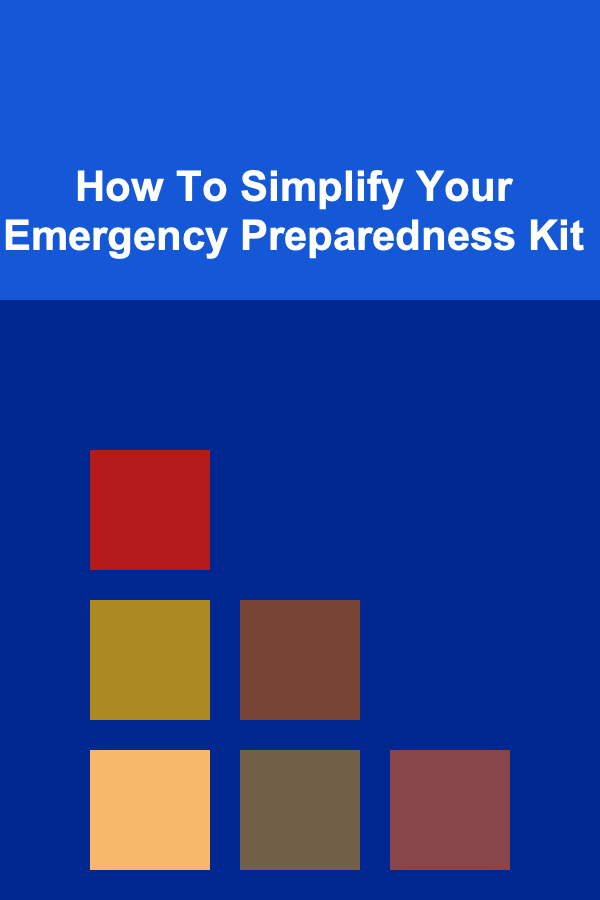
How To Simplify Your Emergency Preparedness Kit
ebook include PDF & Audio bundle (Micro Guide)
$12.99$5.99
Limited Time Offer! Order within the next:

In an unpredictable world, being prepared for emergencies is more important than ever. Whether it's a natural disaster, power outage, or a personal crisis, having a well-thought-out emergency preparedness kit can make a significant difference in how you cope and survive. However, one of the challenges many people face when assembling such kits is the overwhelming amount of information and the numerous items that are often suggested. The goal should not be to build an overwhelming, cluttered kit, but rather to simplify it to include the most crucial items that you can easily carry, use, and rely on when needed.
In this article, we will explore how to simplify your emergency preparedness kit, making it both effective and practical. We will cover essential categories, prioritizing core items, and offer insights into organizing your kit for ease of use in times of crisis.
Understand the Purpose of Your Emergency Kit
Before diving into the specifics, it's essential to understand the purpose of an emergency preparedness kit. At its core, this kit is meant to provide the essentials needed to sustain you for a period of time during an emergency. Depending on the type of emergency you're preparing for (earthquake, hurricane, medical emergency, or power outage), the kit may differ in terms of the items it contains, but the ultimate goal is the same: to give you the resources necessary to survive and remain safe.
A well-simplified emergency kit is one that focuses on versatility, easy portability, and long shelf life. Too many unnecessary items can weigh down your kit and detract from its functionality, so the key is to focus on the essentials and ensure they can be used in multiple scenarios.
Determine the Basics: Food, Water, and Shelter
The core of any emergency kit revolves around three basic human needs: food, water, and shelter. These items will keep you alive and help you maintain your physical well-being in an emergency. Simplifying your kit begins with selecting the right food and water storage methods and making sure your shelter options are versatile and easy to use.
a. Water
Water is the most crucial element in an emergency situation, and it's essential to prioritize it above other items. On average, humans need at least one gallon of water per person per day for drinking, cooking, and hygiene.
To simplify water storage, consider:
- Water purification tablets or filters: These small, lightweight solutions allow you to purify water from natural sources, which can reduce the amount of bottled water you need to store.
- Collapsible water containers: Instead of large, heavy water jugs, consider collapsible containers that are easier to store and transport.
- Water bottles with built-in filters: These can help provide immediate access to clean water, reducing the need for separate purification methods.
In total, aim for a minimum of three days' worth of water for each person in your household, but adjust based on specific needs.
b. Food
In an emergency, you'll need food that is non-perishable, easy to prepare, and compact. Simplify your food choices by focusing on high-calorie, nutritious options that require minimal preparation.
- Freeze-dried meals: These are convenient, lightweight, and require only water to prepare. Many companies offer freeze-dried meal kits that cater to various dietary preferences.
- Energy bars and snacks: Choose nutrient-dense options like granola bars, protein bars, or trail mix that provide a quick energy boost without the need for cooking.
- Canned goods: If you prefer canned foods, go for those that can be eaten cold, such as canned beans, tuna, or fruit. Make sure you have a can opener included in your kit.
In total, you should have enough food to last at least three days per person, with a focus on foods that provide sufficient calories and nutrients to sustain you.
c. Shelter
Shelter needs depend on the nature of the emergency, but generally speaking, you will need a way to stay warm, dry, and protected from the elements. You can simplify shelter by focusing on items that are compact and easy to set up.
- Emergency Mylar blankets: These lightweight blankets are compact, heat-reflective, and designed to retain body warmth in cold conditions.
- Tents or tarps: If you're planning for an extended emergency or are going into a remote area, a small, portable tent or tarp can provide shelter from rain, wind, or sun.
- Sleeping bags: A good-quality, weather-appropriate sleeping bag will help ensure you stay warm and comfortable if you need to sleep outdoors or in an unheated space.
When selecting shelter items, prioritize ease of use and versatility, especially if you have limited space or if you plan to carry the kit in a bug-out bag.
Essential First-Aid Kit
A first-aid kit is another vital component of an emergency preparedness kit. The goal is to simplify the contents while ensuring that you can address minor injuries, illnesses, or other medical concerns until help arrives or you can get to a medical facility.
a. Basic First-Aid Supplies
- Bandages: Include a variety of band-aids (different sizes), gauze pads, and adhesive tape to cover cuts and wounds.
- Antiseptic wipes or ointment: These can help clean wounds and prevent infection.
- Pain relief medication: Keep basic over-the-counter medications such as ibuprofen, acetaminophen, and aspirin.
- Tweezers and scissors: These tools are essential for removing splinters, cutting bandages, or handling other minor medical needs.
b. Personal Medications
If anyone in your household requires prescription medications, ensure you have at least a 7-day supply in your emergency kit. Organize these medications in a waterproof, labeled container to avoid confusion.
c. First-Aid Manual
If you're not well-versed in first aid, consider adding a small, portable first-aid manual to your kit. This can help guide you through basic medical procedures if you need to respond to injuries or illness.
Multi-Use Tools and Gear
Simplifying your emergency kit also involves selecting tools and gear that are versatile and can serve multiple purposes. When you need to minimize space and weight, choose items that combine functions to maximize efficiency.
a. Multi-tool
A high-quality multi-tool can replace several items in your kit. Look for tools with essential functions such as a knife, pliers, screwdrivers, bottle opener, and scissors. This compact tool can come in handy for everything from food preparation to making repairs.
b. Flashlight and Batteries
A reliable flashlight is a must-have in any emergency kit. LED flashlights are energy-efficient and durable. Be sure to include extra batteries in your kit or invest in a rechargeable flashlight that can be powered by a hand crank or solar energy.
c. Portable Power Bank
To keep your essential devices charged (such as phones or medical equipment), a portable power bank is a great addition. Choose a high-capacity power bank that can charge your devices multiple times and is lightweight enough to carry with ease.
d. Rope or Paracord
Paracord is incredibly strong, lightweight, and versatile. It can be used for various purposes, such as securing items, setting up shelter, making a splint, or even creating makeshift tools.
e. Duct Tape
Duct tape is another multi-purpose item that can serve countless functions in an emergency, such as repairing tents, sealing leaks, or even treating injuries (in case you need to create a makeshift splint).
Important Documents and Personal Items
In the chaos of an emergency, it's crucial to have access to your essential documents and personal items. Keep these in a waterproof container or ziplock bags to ensure they stay protected.
a. Identification and Medical Records
Include copies of important documents such as identification cards, medical records, insurance information, and emergency contacts. These items will be useful if you need to seek medical help or verify your identity in an emergency situation.
b. Cash
ATMs and credit card machines may not be functioning during a crisis, so having a small amount of cash on hand (in small bills) can be extremely useful.
c. Personal Hygiene Items
To maintain basic hygiene, include travel-sized toiletries such as soap, toothpaste, wet wipes, and a toothbrush. A small, compact towel or washcloth can also be included.
Keep Your Kit Organized
Organization is key to simplifying your emergency kit. A disorganized kit can make it harder to find what you need in an emergency. Use clear, labeled containers or bags to separate and organize items based on their function.
- First-aid supplies should be stored in a labeled, easy-to-access container.
- Food and water should be stored together, and their expiration dates should be checked regularly.
- Tools and gear can be stored in a separate section for easy retrieval.
Ensure that everyone in your household knows where the kit is stored and understands how to use the items within it.
Conclusion
Simplifying your emergency preparedness kit doesn't mean compromising on safety or preparedness. By focusing on the essentials---food, water, shelter, medical supplies, and versatile tools---you can create an efficient and functional kit that meets your needs in times of crisis. The key is to balance practicality with portability, ensuring that you have the resources you need without overwhelming yourself with unnecessary items. With proper planning and organization, your simplified emergency kit will give you peace of mind, knowing that you're prepared for whatever may come your way.

How to Build a Checklist for Staying Updated with Social Media Trends
Read More
How to Implement Blockchain for Insurance Claims Processing
Read More
How to Set Up a Homework Station with Essential Supplies
Read More
How to Tackle Dusting in Every Room of Your Home
Read More
How to Explore Genetic Fingerprinting in Forensics
Read More
How to Process Color Negative Film with DIY Chemistry
Read MoreOther Products

How to Build a Checklist for Staying Updated with Social Media Trends
Read More
How to Implement Blockchain for Insurance Claims Processing
Read More
How to Set Up a Homework Station with Essential Supplies
Read More
How to Tackle Dusting in Every Room of Your Home
Read More
How to Explore Genetic Fingerprinting in Forensics
Read More